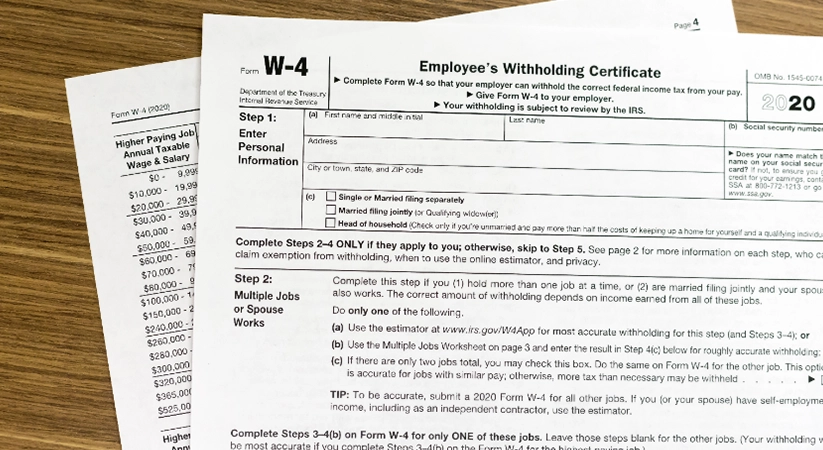
Very Important: The allowance on W-4 is not like an allowance from your parents.
Accurately claiming dependents on your W-4 form is crucial for ensuring the correct amount of tax is withheld from your paycheck. If you fail to claim your dependents, you may end up owing more taxes at tax time or receive a smaller refund. On the other hand, if you claim too many dependents, you may end up owing taxes or face underpayment penalties. Therefore, carefully follow each step when claiming dependents on your W-4 form to ensure you receive accurate withholding and maximize your tax benefits.
Dependents vs. Allowances
When filling out a W-4 form, it’s important to understand the difference between dependents and allowances. While both terms are related to how much tax you owe or get refunded, they refer to different aspects of your financial situation. Dependents are individuals who rely on you for their support, such as children or elderly relatives.
On the other hand, allowances are a number that determines how much money will be withheld from your paycheck for tax purposes.
Form W-4 Uses Allowances, Not Dependents
When completing a W-4 form for federal income tax withholding, understanding the definition of a dependent is crucial. According to the IRS, a dependent is an individual who either qualifies as a “qualifying child” or a “qualifying relative.”
To qualify as a “qualifying child,” the individual must meet several criteria, including being under the age of 19 (or 24 if a full-time student), being a U.S. citizen or resident alien, and having the same principal abode as the taxpayer for more than half the year. Additionally, the “qualifying child” must not provide more than half of their own support and cannot file a joint tax return.
A “qualifying relative” is an individual who is not a “qualifying child” but does meet other criteria. They must have received more than half of their support from the taxpayer in question and must not have earned more than the personal exemption amount for the relevant tax year. The “qualifying relative” can include parents, grandparents, siblings, and other direct ancestors.
Claiming dependents on a W-4 form can have certain caveats that taxpayers need to be aware of. Firstly, claiming too many dependents can result in under-withholding, leading to a tax bill at the end of the year. In contrast, claiming too few dependents can lead to over-withholding and a smaller paycheck throughout the year.
It is important to note that the number of allowances claimed on a W-4 form does not have to match the exact number of dependents on a taxpayer’s tax return. The allowances are meant to help the employer estimate how much federal income tax to withhold from the employee’s paycheck. As such, allowances can also be claimed for tax deductions, such as mortgage interest or charitable donations.
Besides the number of dependents, there are other reasons why taxpayers may want to reduce the number of claimed allowances. For instance, taxpayers who earn income through side jobs or freelance work may need to claim fewer allowances to prevent under-withholding.
Allowances and Tax Withholdings: Are They Essentially Dependents?
The number of allowances claimed on a W-4 form is important because it determines how much federal income tax is withheld from an employee’s paycheck. It’s essential to enter the right number of allowances to avoid over or under withholding.
To determine the correct number of allowances, employees need to consider factors such as their filing status, the number of dependents they claim, and their estimated tax liability at the end of the year. To do this, they can use the IRS’s Tax Withholding Estimator tool or consult tax professionals for guidance.
For example, if someone has multiple dependents, they may want to claim more allowances to reduce their tax withholdings. In contrast, someone with no dependents may want to claim fewer allowances to ensure they don’t owe taxes come tax season.
In addition, significant life events such as getting married, having a child, or buying a home can impact an employee’s tax liability and the number of allowances they should claim.
7 Steps to Filling out Form W-4, Including Putting the Right Number of Dependents
Step 1: Gather the Information You Need
Before filling out the W-4 form, it’s crucial to gather all the necessary information to ensure accuracy. This includes your personal details, such as your name, address, filing status, and social security number.
If you plan on claiming dependents, you’ll need their information as well. This includes their name, social security number, and relationship to you. Dependents can include children under the age of 19 or up to 24 if they’re full-time students, as well as other qualifying individuals such as elderly parents.
Gathering all this information beforehand will make the process of filling out the W-4 form much smoother and efficient. Without this information, you may not be able to accurately claim deductions or credits, potentially leading to an underpayment penalty or a smaller tax refund.
So, take the time to gather all the necessary details before filling out the form to ensure accurate withholding and avoid any unnecessary issues come tax time.
Step 2: Fill out Your Information
Step 2 of the W-4 form requires you to provide your personal information for tax-filing purposes. This step is crucial to ensure that your employer withholds the correct amount of federal income tax from your paycheck. In this section, you will need to enter your full name, address, and Social Security number.
Your filing status will also need to be specified in Step 2. It’s important to choose the option that accurately reflects your current marital and household situation, as this affects your tax liability.
If you are married and filing jointly, you will need to provide your spouse’s name and Social Security number as well. If your spouse is not working or does not have income, you can claim an additional personal exemption.
Make sure to provide accurate and up-to-date information in this section, as any errors or discrepancies can lead to underpayment or overpayment of taxes. Inaccurate filings can result in penalties and fees, so take extra care when entering your personal information in Step 2.
Step 3: Select “Married Filing Jointly” or “Head of Household” Filing Status
When filling out your W-4 form, it’s important to choose the right filing status to accurately represent your current situation. For those with dependents, the two filing statuses to consider are “Married Filing Jointly” and “Head of Household”.
If you’re married and file jointly, you and your spouse will report your combined income on one tax return. This can often lead to a lower tax rate and a higher standard deduction. However, both you and your spouse are responsible for the taxes owed on your joint income.
On the other hand, if you’re unmarried, but pay more than half the cost of maintaining a home for a qualifying dependent, you may be eligible to file as “Head of Household”. This filing status often has a higher standard deduction than filing as a single person and can result in a lower tax rate.
Determining which filing status is appropriate for you depends on your specific tax situation. Consider factors such as your marital and household status, income, and number of dependents when making this decision. It’s essential to select the right filing status on your W-4 form to ensure accurate withholding and prevent any penalties for underpayment.
Step 4: Claim Your Exemptions and Dependents
Step 4 of the W-4 form allows you to claim personal exemptions for yourself and your spouse, as well as any additional dependents you may have. By doing so, you can lower the amount of federal income tax withheld from your paycheck.
You are allowed to claim one exemption for yourself, and another for your spouse if you file jointly. If you have dependents, you can claim an additional exemption for each qualifying child or relative.
In addition to claiming personal exemptions and dependents, you can also use Step 4 to claim any tax credits or deductions you are eligible for. For example, you may be able to claim the Child Tax Credit if you have children under the age of 17, or the Earned Income Tax Credit if you have a low or moderate income.
Step 5: Calculate Your Withholding Allowance Amounts
Step 5 of the W-4 form requires you to calculate your withholding allowance amounts using the number of allowances computed in Step 4. To do this, you will need to use the Personal Allowances Worksheet provided on the W-4 form.
The worksheet is designed to help you determine the number of withholding allowances you should claim on your W-4 form. It takes into account your filing status, the number of dependents you have, your financial situation, and other relevant factors.
To calculate your withholding allowance amounts, simply follow the instructions on the worksheet. Once you have completed all the necessary calculations, the number you arrive at is the amount of allowances you should claim on your W-4 form.
Step 6: Enter Additional Withholding Amounts, if Any
Step 6 on the W-4 form is where you can enter any additional withholding amounts that you may need to account for. This step is particularly important if you have non-job income or if you have more than one job.
To determine if you need to enter an additional withholding amount, refer to Step 4c on the W-4 form. This step asks you to complete the Multiple Jobs Worksheet if you have multiple jobs or if your spouse has a job. The worksheet will help you determine if you need to enter any additional amounts in Step 6.
Additionally, if you have non-job income, you may need to enter an additional withholding amount. You can use the Deductions Worksheet on the W-4 form to help determine if you need to make any adjustments to your withholding.
It’s important to note that failing to withhold enough taxes throughout the year can result in underpayment penalties come tax time. To avoid this, carefully consider whether you need to enter any additional withholding amounts on your W-4 form. The IRS also offers a Tax Withholding Estimator tool to help you calculate your withholding accurately.
Step 7: Sign, Date, and Submit the Form
Step 7 of the Form W-4 requires you to sign and date the form. This step is important as it validates the accuracy and completeness of your information. By signing and dating the form, you are certifying that the information you provided is true and correct to the best of your knowledge.
Remember, completing the Form W-4 is only necessary when starting a new job or when making changes to your withholding amounts. However, if you experience a life event such as the birth of a child or a change in marital status, you may need to revisit your withholding amounts and update your Form W-4 accordingly.
Benefits of Claiming Dependents on a W4 Form
Reduced Taxable Income
Claiming dependents on a W-4 form can lead to reduced taxable income, which can have several benefits for taxpayers. Dependents, such as children, qualify for personal exemptions on the W-4 form. These exemptions are deductions that reduce the amount of taxable income for each dependent claimed. The result is a lower tax liability and potentially a larger tax refund.
By accurately claiming the correct number of dependents on the W-4 form, taxpayers can also avoid underpayment penalties and ensure accurate withholding of federal taxes. Additionally, reducing taxable income can result in a higher eligibility for certain tax credits, such as the child tax credit.
Increased Refund Possibilities
Claiming dependents on a W-4 form can increase the chances of getting a higher tax refund. When you claim dependents, it lowers your taxable income, which, in turn, reduces your tax liability. By reducing your tax liability, your overall tax bill decreases, and the chances of getting a higher tax refund increase.
To increase your refund possibilities, it is essential to claim the correct number of allowances on your W-4 form based on your tax situation. The number of allowances to claim depends on a variety of factors. It is crucial to review your tax situation and adjust your W-4 accordingly.
Things to Consider Before Claiming Dependents on a W4 Form
Before claiming dependents on a W4 form, there are several things you need to consider to ensure accuracy and avoid penalties. Claiming dependents can affect your tax situation, so it’s important to understand all the implications before making any decisions. This article will outline the key factors to keep in mind when claiming dependents on a W4 form, including who qualifies as a dependent, the impact on your tax return, and how to accurately calculate the number of allowances you should claim.
Make Sure All Eligibility Requirements Are Met
If you’re filling out a W-4 form and plan to claim dependents, it’s important to make sure you meet all the eligibility requirements set forth by the IRS. The agency has strict guidelines on who can qualify as a dependent, including requirements related to the relationship between the taxpayer and dependent, residency, age, and support provided.
To be eligible to claim someone as a dependent, the IRS requires that they be your child, stepchild, foster child, sibling, parent, grandparent, or another related individual who meets the residency, age, and support requirements. The dependent must also be a U.S. citizen, or resident alien, and cannot file a joint return with another taxpayer.
Additionally, the dependent must have lived with you for more than half of the year, or meet certain exceptions for temporary absences, and must be under the age of 19, or a full-time student under the age of 24 unless they are permanently and totally disabled.
It’s important to carefully review the eligibility requirements and ensure that you meet all qualifications before claiming dependents on your W-4 or tax return. Failing to meet the criteria can lead to a reduction in tax credits, deductions, or even underpayment penalties.

Jessie Seaman
Jessie Seaman, Esq. & EA, is a Florida attorney and IRS Enrolled Agent with over 12 years of experience in state and federal tax controversy resolution. Passionate about helping individuals and businesses navigate complex tax challenges, Jessie combines her legal expertise with a dedication to education, often mentoring future tax professionals and speaking at national conferences. A double major graduate from the University of South Florida and a Juris Doctor recipient from Florida Coastal School of Law, she has overseen tens of thousands of tax resolution cases, from simple privacy plans to high-profile matters. Jessie currently resides in Chicago, enjoying outdoor adventures with her Pomsky, Fisher.







